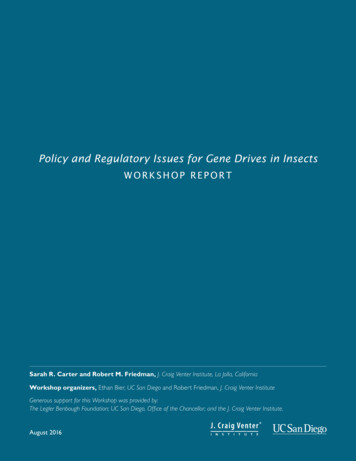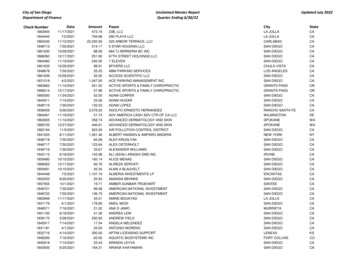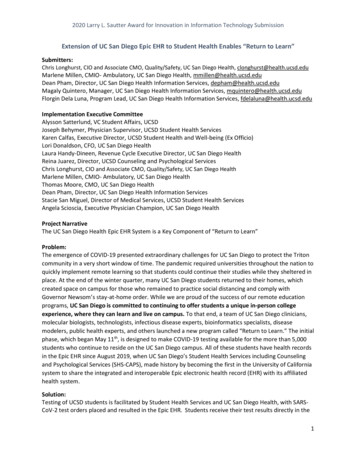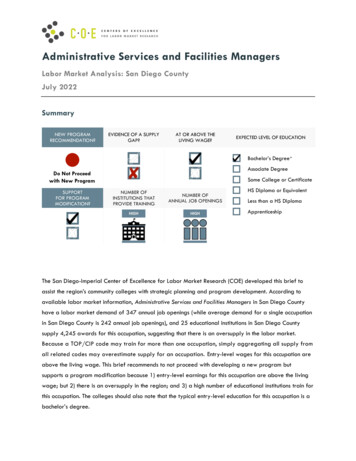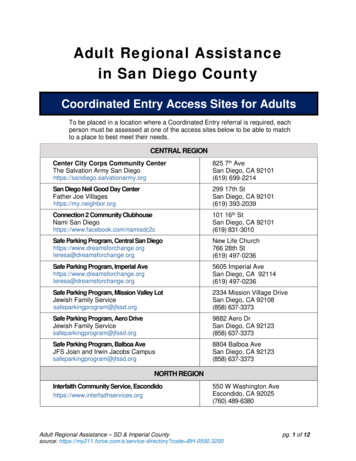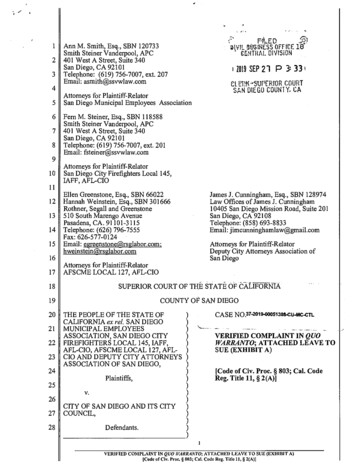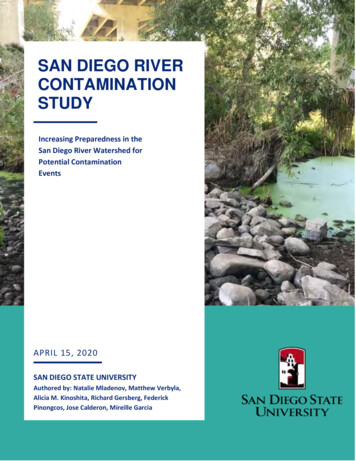
Transcription
SAN DIEGO RIVERCONTAMINATIONSTUDYCONTAMINATIONIncreasing Preparedness in theSTUDYSan Diego River Watershed forPotential ContaminationEventsAPRIL 15, 2020SAN DIEGO STATE UNIVERSITYAuthored by: Natalie Mladenov, Matthew Verbyla,Alicia M. Kinoshita, Richard Gersberg, FederickPinongcos, Jose Calderon, Mireille Garcia1
EXECUTIVE SUMMARYIntroductionDistinguishing anthropogenic fecal pollutant inputs to streams is currently one of the most pressingenvironmental challenges for urban water managers. Although stormwater enters urban waterwaysfrom municipal separate storm sewer systems (MS4s) rather than from combined sewer systems(CSSs), streams and rivers in Southern California often exceed water quality targets for fecal indicatorbacteria, and human pathogens have been detected during wet weather conditions. Pathogenicmicroorganisms and other pollutants may be introduced to streams from both surface and subsurfacesources, and the relative importance of different sources is not yet well understood. In this study,microbial source tracking (MST) markers and chemical markers were measured in water and soils toevaluate pollutant inputs to the San Diego River and its tributaries from untreated wastewater andfecal waste associated with homeless encampments. The study was conducted from January 2018 toMarch 2019 and focused on the two hydrologic years following the Hepatitis A outbreak in San Diego,which included cases among the unsheltered population in San Diego. The MST and chemical markersused can help distinguish human-associated fecal pollution from general fecal pollution (which canalso originate from other warm-blooded animals).Dry weather contaminant inputsWater samples collected during dry weather conditions at locations directly upstream anddownstream of three active homeless encampments along the San Diego River and two of itstributaries had greater downstream concentrations of fecal indicator bacteria, Escherischia coli andfecal enterococci, but these bacteria may also originate from non-human fecal sources, such as petsand birds. By contrast, a human-associated microbial indicator of fecal pollution, the HF183 marker ofBacteroides, was only detected sporadically, and the concentrations were too low to conclude if therewas a significant difference between upstream and downstream samples. There was also nosignificant change in the concentrations of caffeine and sucralose, two chemical pollutants associatedwith human waste. Overall, there was no evidence that homeless encampments are causing increasesin the concentration of microbial pollutants in water during dry weather conditions.“Homeless encampments did not have a significant influenceon microbial pollution of surface waters during dry weather.”2
On the other hand, soils sampled in the vicinity of open defecation sites during homelessencampment cleanups tested positively for E. coli, enterococci, and HF183. However, HF183 was notdetected in the soils one month after cleanup. There is evidence that the soils (but not the adjacentwaters) within a former encampment are contaminated with fecal pollution, and therefore,environmental workers should use personal protective equipment (e.g., gloves) when handling orworking around soils at former encampment sites, especially soils located near sites with evidence ofopen defecation.“Homeless encampments did result in microbial contaminationof soils at encampment sites, even after site cleanup.”Wet weather contaminant inputsKnowledge of the fate and persistence of biological and chemical markers from untreated wastewaterexfiltrating from cracked and aging sewer infrastructure or discharging into waterways from sanitarysewer overflows (SSO) is essential to evaluate contributions of human fecal material to the San DiegoRiver and its tributaries. Untreated wastewater had substantially higher caffeine (approximately 200µg/L on average) than sucralose (approximately 25 µg/L). A caffeine/sucralose ratio of greater than 2was found to be indicative of wastewater inputs to surface waters. The MST markers, HF183 andpepper mild mottle virus (PMMoV), a virus found in pepper-based sauces consumed almostexclusively by humans, were also measured in this study. The bacterial marker, HF183, was more thanan order of magnitude higher in wastewater ( 106 copies/100 mL) than the viral marker, PMMoV(approximately 105 copies/100 mL).Experiments were also conducted to evaluate the persistence of microbial pollutants in soils fromsimulated sewer exfiltration and SSO events during wet weather. For soils spiked in the laboratorywith untreated wastewater, E. coli concentrations decreased exponentially from 107 MPN/100 mL onthe first day of the experiment to 100 MPN/100 mL, levels that were still measurable, even 4 monthsafter spiking. The MST markers, HF183 and PMMoV, were also measured at concentrations of 100copies/100 mL to 1000 copies/100 mL four months after spiking. PMMoV had greater persistence indry soils than HF183.“Wastewater-spiked soils continued to be a source of E. coli,enterococci, HF183, and PMMoV even after 4 months.”3
To simulate storm conditions, wastewater-spiked soils were also flushed repeatedly on the day afterspiking. After 20 consecutive flushes, wastewater-spiked soils remained a source of E. coli ,enterococci, and HF183, but not PMMoV. PMMoV was flushed away from soils after the first 2flushes, possibly due to its smaller size and greater mobility in soils. These results provide newinformation on the typical concentrations of MST markers in wastewater contaminated soils that mayserve as a guide for future tracking of wastewater inputs during storm events.To simulate the leaching of pollutants from open defecation sources into stormwater, runoffexperiments were conducted using a runoff simulation device at sites adjacent to the river withhuman feces on the soil surface. These experiments revealed several important findings about opendefecation. Concentrations of E. coli and enterococci remained unchanged after multiple flushes ofhuman fecal material on soil surfaces; therefore, open defecation is likely to be a continuous source offecal indicator bacteria over the length of a storm event. Also, the human microbial marker, PMMoV,and the chemical marker, sucralose, were measured in every runoff experiment and found to bepersistent in human fecal material in the environment. However, both HF183 and caffeine, wereeither absent or present in very low (undetectable) concentrations in the runoff experiments, whichmay be due to the short lifetime of both HF183 and caffeine in the environment. Combined withearlier evidence of high concentrations of HF183 and caffeine in untreated wastewater, these runoffexperiment results indicate that increases in caffeine and HF183 concentrations in surface water arelikely an indication of untreated wastewater inputs rather than open defecation inputs.“Caffeine and HF183 are found in high concentrations inuntreated wastewater and almost undetectable instormwater runoff from soil with open defecation.”Source tracking during storm eventsMonitoring of pollutagraphs for the San Diego River and its tributaries during storm events fromJanuary 2018 to March 2019 revealed that E. coli and enterococci concentrations exceeded wetweather targets by several orders of magnitude, with the highest concentrations ( 105 MPN/100 mL)and loadings ( 1013 MPN/d) observed during the two largest storm events. Samples were alsoanalyzed for gene targets of a fecal indicator virus (coliphage PhiX174), human associated chemicalmarkers (caffeine and sucralose), human-associated biological markers (HF183 and PMMoV),pathogenic human viruses (Hepatitis A virus [HAV] and norovirus GI [NoVGI]), pathogenic bacteria(Campylobacter coli and Campylobacter jejuni), dissolved organic carbon, total dissolved nitrogen,nitrate, and phosphorus. Samples collected from the San Diego River during a major storm (February2018), which had strong evidence of SSO influence, had no detectable levels of HAV or C. jejuni, but4
the human pathogen, C. coli was detected. Subsequent storms also did not have measurableconcentrations of HAV or C. jejuni; however, the human pathogen NoVGI was detected in the SanDiego River during the first rain event of the 2018 hydrologic year, following 150 antecedent dry days.The most telling information regarding sources of contamination comes from pollutagraphs of HF183,caffeine, and sucralose, which showed caffeine/sucralose ratios greater than 2 and large increases inHF183 during and after the peaks of storm hydrographs. The trends in concentrations of MST andchemical markers, as well as other chemical parameters, over the course of each storm suggest thatuntreated wastewater, from sewer exfiltration or SSOs, is the main source of microbial contaminationin the San Diego River during storm events. Corresponding chemical analyses indicated that soilsbecome saturated over the course of most storms, potentially mobilizing contaminants from thesubsurface, where untreated wastewater may have accumulated around sewer pipes or where sewersmay actively be leaking wastewater to the surrounding environment. Evidence also showed that,during very low volume rain events, in which surface runoff is the dominant mechanism for flushingpollutants into the water column, HF183 was undetectable and E. coli and fecal enterococciconcentrations were one to two orders of magnitude lower than during larger storms. These resultsindicate that flushing of open defecation sources during surface runoff may transport pathogenicmicroorganisms into the water column, but that this source likely represents only a fraction of themicrobial pollutant inputs that occur from untreated wastewater. Overall, untreated wastewatersources are likely responsible for the majority of elevated microbial pollutants detected in the SanDiego River and its tributaries during storm events.“Untreated wastewater was found to be the main sourceof San Diego River pollution during storm events.”This study suggests that efforts to address contamination of the San Diego River and its tributaries andmeet wet weather pollution targets should prioritize replacement of cracked or failing sewerinfrastructure or containment of sanitary sewer overflows. Despite the potentially lesser contributionof open defecation sites to pollutant loadings in the San Diego River during storm events, wasteassociated with homeless encampments remains an important source of fecal pollution to soils.Provision of improved water supply, sanitation, and hygiene facilities is recommended for unshelteredindividuals experiencing homelessness in the region.5
AcknowledgementsWe acknowledge funding and support from the San Diego River Conservancy, California State WaterResources Control Board, Region 9, San Diego State University Division of Graduate Affairs, Office ofCouncilmember Scott Sherman (District 7) of the City of San Diego, Office of Councilmember Lori Zapf(District 2) of the City of San Diego. We are grateful for assistance with field work and access to dataand study sites provided by the San Diego River Park Foundation and the City of El Cajon. A talentedgroup of students assisted with field and laboratory work; we thank J. Calderon, F. Pinongcos, M.Garcia, M. Gil, J. Monroe, C. Batikian, H. Bertsch, B. Carlson, C. Carr, S. Chao, F. Espinosa, D. Garcia, A.Gaunin, C. Graves, A. Jaramillo, A. Kinney, L. Mendoza, I. Musaazi, E. Mikita, K. O’Marah, T. Sadeque,A. Sanchez, J. Simmons, E. Winterton, A. Wong, F. Zhao and many other SDSU students for the timeand effort they donated to this project.6
Councilmember Scott Sherman (District 7) of the City of San Diego, Office of Councilmember Lori Zapf (District 2) of the City of San Diego. We are grateful for assistance with field work and access to data and study sites provided by the San Diego River Park Foundation and the City of El Cajon. A talented
